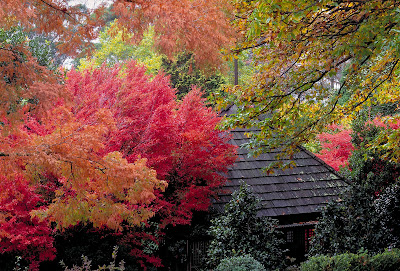Danger Will Robinson! Autumn Leaves!*

You can just enjoy the spectacular autumn colours at Mount Tomah Botanic Garden or you can ask why. I like to do both. Recently there have nearly as many theories about why leaves turn yellow, or particularly red, as there have been autumn leaves – well, not quite.
In fact I've already blogged about this before (see I See Red), and the following is a rewrite of that for my regularly interview with Simon Marnie*.
Leaves are usually green because they have more of the green chlorophyll than other pigments. In deciduous trees, the chlorophyll breaks down into useful colourless compounds just before the leaves drop.
As the green fades, yellow and orange pigments (carotenoids) become visible and colour the leaf. But red autumn leaves are different. The reds and purples (anthocyanins) aren’t found in green leaves but are produced by the plant while about half the chlorophyll has been broken down. So red autumn leaves are not just due to the green fading away, and that intrigues plant biologists.
A popular theory among plant physiologists is ‘photoprotection’, where red pigments act like a kind of sunscreen to protect the innards of the leaf while it reabsorbs important compounds from the green chlorophyll. Apparently damage from sunlight is more likely in autumn due to lower temperatures slowing down some internal processes, thinning of the canopy leading to higher light levels and the reduction in chlorophyll itself decreasing the ‘shading’ of the inner cells.
There is some evidence for a screening effect and antioxidant role for red anthocyanins, but not so much in senescing leaves. And as yet no proof that red leaves help in absorption of nutrients from chlorophyll breakdown.
Ecologists are more attracted to ‘coevolution’ concept, where red is a warning signal to insects (Danger, Will Robinson!) that the leaves are full of nasty chemicals, very few nutrients or about to drop. This would help the insects because they wouldn’t lay eggs in places where their young are not likely to survive. It may help the tree in reducing insect damage when new leaves are produced in spring – if the eggs do survive and the insects last the winter.
It’s a classic evolutionary arms race scenario, where plant and predatory (or disease carrying) insect try to reduce the impact of each other so they can produce more offspring – the driver for evolutionary adaptation. There is some weak evidence for this coevolution and aphids, in particular, prefer green over red leaves. Yet another study showed that red apple leaves were not attractive to aphids. But there is a rub – aphids can’t tell green from red, and it may associated chemicals or attributes that attract and repel.
In a comparison of these two theories published last year, it was clear the jury is still out. And a note from Science (issue 324, 24 April 2009) about a later study of aphids and apple trees in Proceedings of the Royal Society B reinforced the theory that the red hue wards off insects looking for a leafy snack or a place to nest.
'Clearly', both theories, and others, may all be true, or not.
If you want to know why autumn leaves are red in America and yellow in Europe, see my Colour and Movement posting).
Image: Autumn colours at Mount Tomah Botanic Gardens by Jaime Plaza
*This Passion for Plants posting will also appear on the ABC Sydney website (possibly under 'gardening'), and is the gist of my 702AM radio interview with Simon Marnie on Saturday morning, between 9-10 am.
*This Passion for Plants posting will also appear on the ABC Sydney website (possibly under 'gardening'), and is the gist of my 702AM radio interview with Simon Marnie on Saturday morning, between 9-10 am.
Comments